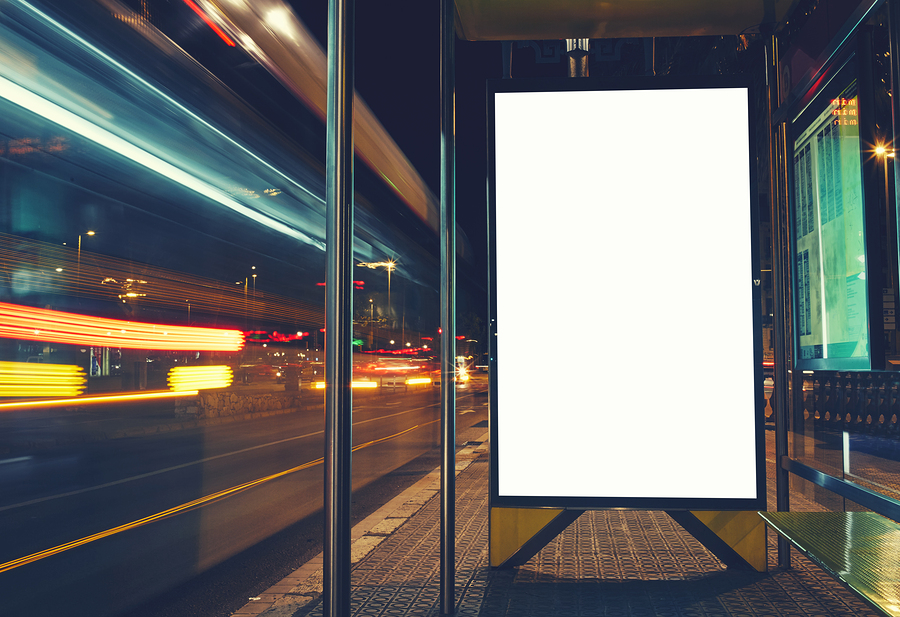
Robohub.org
Replacing public transit at night for Uber and Lyft

Perhaps one day advertising signs will be replaced by mini-kiosks with a protective case and a surplus tablet for hailing Uber rides.
I have a big article forthcoming on the future of public transit. I believe that with the robocar (and van) it moves from being scheduled, route-based mass transit to on-demand, ad-hoc route medium and small vehicle transit. That’s in part because of the disturbingly poor economics of current mass transit, especially in the USA. We can do much better.
However, long before that day, there is something else that could be done. Many mass transit systems shut down at night. Demand is low, and that creates a big burden for the “night people” of the world, who are left with taxis and occasional carpooling, or more limited night bus service.
I think transit agencies should make a deal with companies like Uber to operate their carpool services (UberPool and LyftLines) during transit closure hours, and subsidize the rides to bring them down equal to, or closer to a transit ticket. This could also be the case for other seriously off-peak times, like weekends and holidays.
Already the typical transit ticket in the USA is heavily subsidized. The real cost of providing a transit ride is much higher. In the transit-heavy cities, fares pay about 50-60% of operating cost, but in some cities it’s only 15-20%. The US national average is around 33%. And that’s just operating cost, it does not include the capital costs in many cases. One thing that pushes the number the wrong way is operation during off-peak hours on lightly loaded vehicles. So while the average ride may cost $6 to provide, it can be more at night. Already the mobile-summoned based carpools are close to that price. (For promotions, they have actually gotten to less. They also subsidize to get going, though.)
There are some big issues. First, not everybody has a smartphone, a data plan or even a phone. You need a method for those without them to summon a ride. You could start with an 800 number so any phone (or the few remaining payphones) could summon a ride. You could also make mini-kiosks by building a protective case and putting a surplus tablet at every subway stop and many bus stops.
Another issue is that these services, particularly the carpool versions, depend on not having anonymous riders. People feel much safer about carpooling with strangers if those strangers can be identified if there is a problem. Transit riding is anonymous, and should be. The solutions to this are challenging. On top of all this, riding in a mobile-hail car is never paid for with cash, and the drivers are not going to accept cash. At the least, this means you would need to provide tickets that people buy (from machines at stations or in advance) which the driver can scan with their phone. So no just deciding to take a ride with cash. Transit cards are an other issue, though there is no requirement that they work, because at least at first, this service is meant for hours when the transit was not even running, so it’s OK if it’s an extra cost.
Finally, there is the issue that this is too good. A ride in a private car vs. a late night transit bus, for the price of a bus? People will over-use it, and that would of course get the taxis angry, though there is no reason they could not participate as they are all going to supporting mobile-app hail. But the subsidy may be too expensive if people over use it.
One solution to that is to only allow it to take you between transit stops. Even that’s “too good” in that it may be faster than the transit, and much faster if the trip involved changes, especially changes during limited service times. You could get extreme and only allow it between limited sets of stops, or require 2 rides (for the same price) to simulate having to change lines. This also makes carpooling much easier, as the drivers would mostly end up cruising close to the transit lines. IF they do it in vans it could be quite efficient, in fact.
We probably don’t need to go that far in limiting it, but we could. You could tune the ease and quality of the service so the demand is what you expect, and the subsidy affordable. And the ride companies could actually use this as a way to gain extra revenue. They could offer you a door to door ride with a subsidy for the portion that would have been along the transit line. For example, today you can take Uber to the subway station, ride the subway for $2 and then take Uber from the end station to your destination, and that can be cheaper than just taking the Uber directly. This ride could be offered at some subsidized price and keep up the volume. The taxi companies can either get into the 21st century and play, or not compete.
Aside from improving transit service (by making it 24 hours) this also lets us experiment with the future world of ad-hoc demand based public transportation, when we get to the future where the vans are driving themselves. More on that to come.
This post originally appeared on robocars.com.
tags: Automotive, Autonomous Cars, Uber




